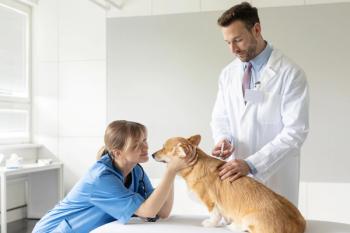
Equine rabies: Do your clients get the message? (sponsored by Intervet/Schering-Plough Animal Health)
Educate horse owners on risk factors and prevention strategies.
It's a viral disease that has threatened humans and animals since antiquity, and it's still fatal almost without exception in all mammals that develop clinical signs.
It's rabies.
As a professional, you know the danger and the importance of keeping horses on a regular vaccination schedule, but are your clients on board and keeping vaccinations current?
Photo: Getty Images
When some equine diseases, particularly eastern equine encephalitis, increased sharply this year, many veterinarians suspected that the weak economy played a role, prompting horse owners either to neglect vaccination or to extend recommended intervals between inoculations. That raises the possibility that some clients might also skip rabies vaccinations for economic reasons, reasoning that exposure is somewhat less common in horses than in other domestic animals.
The American Association of Equine Practitioners, however, emphasizes the importance of the rabies vaccination by identifying it as one of four core vaccinations for horses. Core vaccinations, as defined by the American Veterinary Medical Association, are those that are required by law or those that protect animals from diseases that:
- are endemic to a region
- have potential public health significance
- are highly infectious
- pose a risk of severe disease.
In addition, core vaccines have clearly demonstrated efficacy and safety, exhibiting a high enough level of patient benefit and low enough level of risk to justify their use in the majority of patients.
But educating clients on the matter requires more than just passing along scientific information. Motivation is the key, and to motivate effectively, you need to present a clear, concise plan of action—and repeat it several times. To assist you on that front, Intervet/Schering-Plough Animal Health sponsored a webinar on
Client education shows results
In 2006, 53 rabies cases were reported in horses, according to the CDC—an increase of 12.8 percent over 2005. In 2007, that number decreased by about 20 percent to 42 cases. In 2008, the number dropped again, to 30 cases. Why?
"We believe this decline is likely attributed to increased public awareness and vaccination," says Dr. Cynthia Guitierrez, equine technical services veterinarian for Intervet/Schering-Plough Animal Health. And increased public awareness indicates that many veterinarians are doing a better job of educating clients.
In the webinar, Dr. House emphasizes that the total number of rabies cases reported is a fraction of the cases that actually occur. CDC numbers are based on cases seen and tested, and infected wildlife usually die unnoticed and unreported. Rabies exposure in horses most often occurs through the bite of an infected animal, usually a raccoon, skunk, bat, or fox. "Horses are naturally curious and interested in wild animals that approach them," Dr. House explains. Therefore clients should be advised to limit horses' exposure to wildlife as much as possible.
When an unvaccinated horse is bitten, clinical signs can take anywhere from two weeks to 12 weeks to develop. If the bite occurs on or near the head or neck, signs develop sooner because the virus travels a shorter distance to the spinal cord and brain. If the bite is on the rump, the virus replicates in muscles and takes longer to reach the central nervous system. Once signs do appear, death usually occurs in three to seven days, Dr. House explains.
An infected horse may show behavioral changes such as drowsiness, depression, fear, or aggression. Ataxia may follow, along with hypersalivation and difficulty swallowing. Some infected horses exhibit self-mutilation.
These behaviors usually reflect one of two forms of rabies: "furious," which is less common and marked by increased sensitivity to external stimuli, hyperexcitement, and aggression; and the "stuporous" or "dumb" form of the disease, usually marked by depression, inappetence, and head pressing. Other signs include recumbency, bladder distension, incontinence, and seizures.
Horse owners should be warned not to approach a horse exhibiting signs of rabies or enter its pen to touch it with bare hands. Educate your clients on the importance of wearing gloves, gowns, and other protective equipment—and take such precautions yourself, Dr. House says.
Of course, no treatment options exist once signs appear in a horse. Euthanasia is the only option—and the death is all the more unfortunate since rabies is preventable through vaccination, Dr. House says.
Prime risk factors
According to Dr. House, the horses most at risk for rabies are:
- Those that live in an area where the disease is endemic (which includes the United States, Canada, and most of Europe. The only countries where it's not found are the United Kingdom, Ireland, Iceland, the Scandinavian countries, Australia, and New Zealand.)
- Horses without a history of vaccination
- Horses that live outside on pasture all or most of the time.
"Young horses are somewhat more susceptible than older horses, but there are no breed or gender predispositions," Dr. House says. "And typically the disease will affect only one horse on a farm."
Do you have clients whose horses travel to perform in shows or competitions, or are in contact with people through petting zoos or other events? If so, the Association of State Public Health Veterinarians advises you to make doubly sure those clients have their animals vaccinated for rabies. Dr. House's webinar outlines the recommended vaccination schedules for all horses, including pregnant mares and foals, and she points out that blood titers are not a substitute.
If your client suspects that a horse has been bitten by a rabies-infected animal, what should be done? Contacting you as the veterinarian is always the first step. If the horse was previously vaccinated, revaccinate immediately, Dr. House says. Then isolate and observe the animal for 45 to 90 days (your clinical evaluation will involve gait analysis, radiography, and a spinal tap), and have the client make a list of all the people who had any contact with the horse. If the animal was not vaccinated, your options are to euthanize and perform a postmortem exam of the brain (the only way to definitively confirm rabies), or isolate and observe the horse for six months and develop the human-contact list.
In summary, Dr. House advises you to remind clients regularly of the best ways to prevent rabies: First and foremost, vaccinate. Although vaccination does not provide 100 percent protection, it's extremely effective. Also, counsel your clients to minimize horses' contact with wildlife as much as possible, keep garbage containers on the property securely closed, remove trash, and keep all pet food in secure containers. "Always be proactive with clients, reminding them of yearly rabies vaccinations and educating them about these other precautions," Dr. House says.
Newsletter
From exam room tips to practice management insights, get trusted veterinary news delivered straight to your inbox—subscribe to dvm360.




